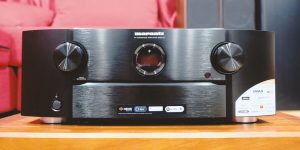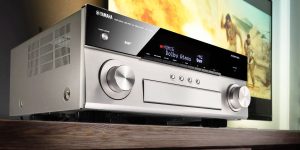Heat inevitably follows any electric device, especially something as complex and powerful as AV Receivers. Sometimes, the line between normal operational conditions and receiver overheating is very blurry. Whether you’re a home theater enthusiast, a music lover, or someone who enjoys high-quality audio and video, it is vital to understand the basics of heating and cooling to know how to avoid overheating.
This article will delve into the importance of proper ventilation and receiver cooling systems for your AV receiver, discussing how heat affects its functionality and exploring practical strategies to ensure your receiver remains in peak condition. Whether you’re an AV enthusiast or a casual user, the insights provided here will help you make informed decisions and take the necessary steps to safeguard your AVR investment. So, let’s check the AV receiver heating problems and discuss efficient cooling and the proper ventilation solutions, ensuring your entertainment experience remains top-notch.
Exploring the consequences of overheating in AV receivers

Overheating is a concern that every AV (Audio-Visual) receiver owner should take seriously, as its consequences can be profound and far-reaching. One of the most apparent inconveniences of overheating is that the receiver turns off occasionally because of the extensive heat.
The reason behind this behavior is that the receiver tries to save its internal circuits from high temperatures by emergency turning off. Modern circuits and electric components can function at high temperatures. For example, quality capacitors can work at 212 degrees Fahrenheit. At the same time, such working conditions significantly reduce their service time. While a certain component can work for 10 years nonstop at normal temperatures, it may break in less than a month when operating inside an overheating receiver.
So, let’s delve deeper into the intricacies of overheating and unravel its extensive impact on these essential entertainment devices.
Explanation of overheating
Overheating is a prevalent issue that plagues AV receivers, and understanding its mechanics is vital. It occurs when the temperature inside the device rises to a level that surpasses the maximum operating temperature specified by the manufacturer. This can transpire under various circumstances, such as prolonged usage, inadequate ventilation, or exposure to high ambient temperatures.
Risks of overheating to AV receiver
The consequences of overheating for an AV receiver are far-reaching and detrimental, potentially compromising the performance and longevity of this critical entertainment component. The risks associated with overheating include:
- Reduced performance: When an AV receiver overheats, its internal components can suffer damage, resulting in compromised sound and video quality. This can manifest as distorted audio, video artifacts, and other aberrations in the entertainment experience.
- Decreased lifespan: Overheating accelerates wear and tear on the receiver’s components, ultimately shortening its lifespan. Essentially, it ages the device prematurely, reducing its reliability over time.
- Permanent damage: In severe cases, overheating can inflict permanent damage on the AV receiver. This can lead to erratic behavior, frequent breakdowns, and, in the worst-case scenario, complete failure of the device.
- Automatic shutdown: As I have said before, many modern models are equipped with safety mechanisms that trigger automatic shutdown when overheating is detected to prevent further damage. While this is a safeguard, it can be a considerable inconvenience for users.
Factors that contribute to overheating

Several factors contribute to the overheating of AV receivers. Considering the fact that you can affect almost each of them and thus can change the situation with heat for the better, it’s essential to recognize these factors to mitigate the risks effectively. Some key contributors include:
Environmental factors
High ambient temperatures can place additional strain on the AV receiver, as the air cooling systems used in modern AVRs cannot get temperatures below the ambient ones. Thus, the higher the ambient temperature in your room, the higher your AV receiver’s operational temperature. Placing the device in a room that lacks air conditioning or in proximity to heat-emitting electronics can exacerbate the problem.
Poor ventilation design in the AV receiver
The internal design of the AV receiver can also play a significant role. What is more important, this is something that you can only change if you have picked a receiver with excellent ventilation in the first place. Thus, inadequate ventilation within the receiver can hinder heat dissipation, trapping hot air and increasing the risk of overheating.
Using the AV receiver for extended periods of time
Long hours of continuous operation, particularly at high volumes, generate more heat within the receiver. This extended usage can push the device beyond its thermal limits, especially when this combines with the previous issues — poor ventilation design and higher ambient temperatures.
Best practices for proper ventilation and cooling

So, as you can see, while being a major problem, you significantly impact the heating issue. Therefore, to safeguard your device from overheating, adopting best practices for proper ventilation and cooling is crucial. These strategies include:
Location of the AV receiver
Choose a suitable location for your AV receiver. Ensure it’s placed in an area with adequate airflow and away from heat sources like radiators or other electronic devices that generate heat. Generally speaking, the cooler the room, the better. However, make sure that you keep the humidity levels under control.
Airflow and ventilation design
Consider the receiver’s ventilation design. Some models have built-in cooling fans and optimized airflow paths. Choosing a receiver with these features can help maintain lower operating temperatures. But don’t pick the first unit with a built-in cooling fan because a proper cooling system combines factors. So, I always recommend doing an extensive research.
Use of cooling fans
If your AVR lacks built-in cooling mechanisms, you can use an external cooling fan for the AV receiver. These can be strategically placed to improve heat dissipation and prolong the life of your device.
By understanding the causes and consequences of overheating and implementing these best practices, you can ensure your AV receiver remains cool and performs at its best, enhancing your audio-visual entertainment experience for years to come.
We are supported by our audience. When you purchase through links on our site, we may earn an affiliate commission at no extra cost to you.
Our newsletter
* We will never send you spam or share your email with third parties















